Medical Tourism Trip Turned into Cartel Abduction for Four Americans
Unidentified gunmen kidnapped four Americans in northern Mexico on 3 March after they were caught in the crossfire of cartel activity. Four days and a major manhunt later, authorities found the victims inside a wooden house on the outskirts of Matamoros, Mexico. Two of the four Americans were dead, one was injured, and the other unharmed after being moved around the city several times in the course of their abduction. A Mexican woman was also killed during the incident, The Guardian reported.
The Americans had traveled from Brownsville, Texas, across the U.S.-Mexico border to Matamoros in a white minivan with North Carolina license plates. Not long after they crossed into Mexico, gunmen wearing what appeared to be bulletproof vests fired upon and abducted the group, according to a video shared on social media. Mexican officials theorize that the kidnapping was a likely case of mistaken identity by the Gulf Cartel, not a direct attack.
Authorities are working to repatriate the Americans killed in the abduction, Zindell Brown and Shaeed Woodard. Latavia "Tay" McGee and Eric James Williams were the two other Americans that were kidnapped, according to the BBC.
The incident drew attention to ongoing violence in Mexico—government figures show that more than 35,000 people were killed in the country in 2021. Border states have been some of the country’s most violent areas, including Tamaulipas—the state where the kidnapping took place, NBC News reported. The U.S. State Department issued a rare “Do Not Travel” warning for Tamaulipas, citing organized crime activity, gun battles, armed robbery, and kidnappings.
“Criminal groups target public and private passenger buses, as well as private automobiles traveling through Tamaulipas, often taking passengers and demanding ransom payments,” the State Department warned.
The kidnapped group was reportedly visiting Mexico for an elective medical procedure. This sort of medical tourism is fairly common in Mexico—nearly 1 million Americans visit Mexico for medical care every year, according to data from the Mexican Council for Medical Tourism Industry. The cost of procedures and medicines is typically lower than U.S. insurance copays, and the quality of care usually matches American standards.
According to the BBC, “Medical shoppers, especially those familiar with the region, have learned to take precautions, like registering their vehicle in Mexico, which allows them to change the license plate to a Mexican one after entering the country by car so they will be less of a target, and avoiding wandering around these towns on foot.”
Violence against Americans in Mexico is relatively rare—even cartels are well-aware of how much the country relies on international tourism—but killings have happened, even in relatively safe tourism centers like Cancún.
The U.S. State Department offered some basic advice on how to mitigate personal risk while traveling in Mexico, including using toll roads when possible; avoiding driving alone or at night; exercising caution when visiting local bars, nightclubs, and casinos; avoiding displays of wealth, such as wearing expensive watches or jewelry; and exercising vigilance when visiting banks or ATMs.










